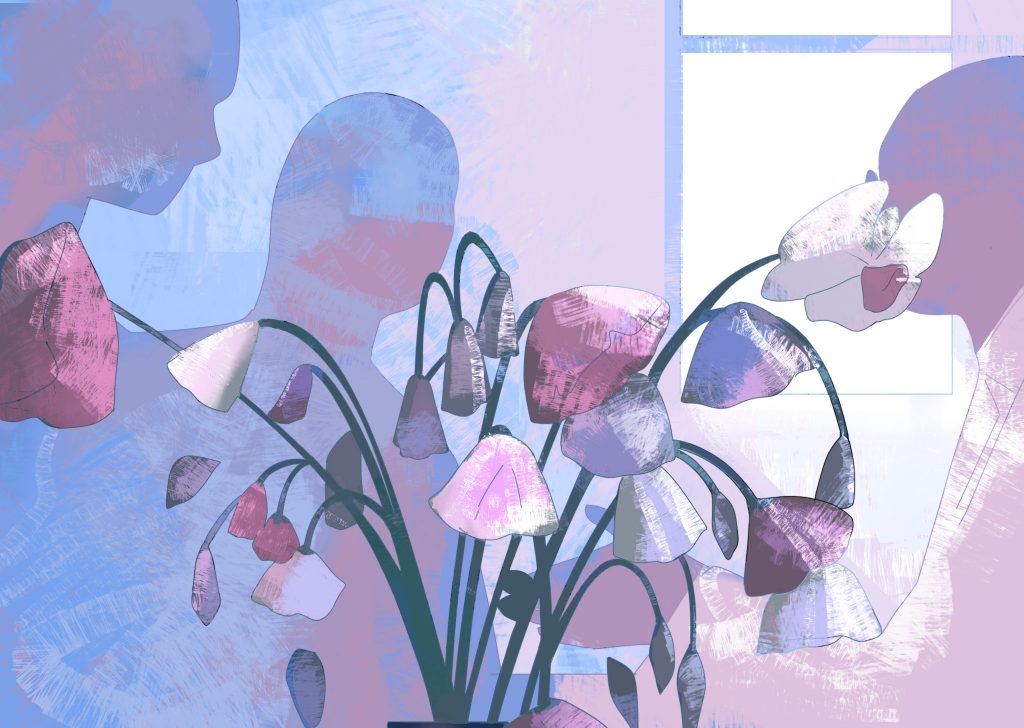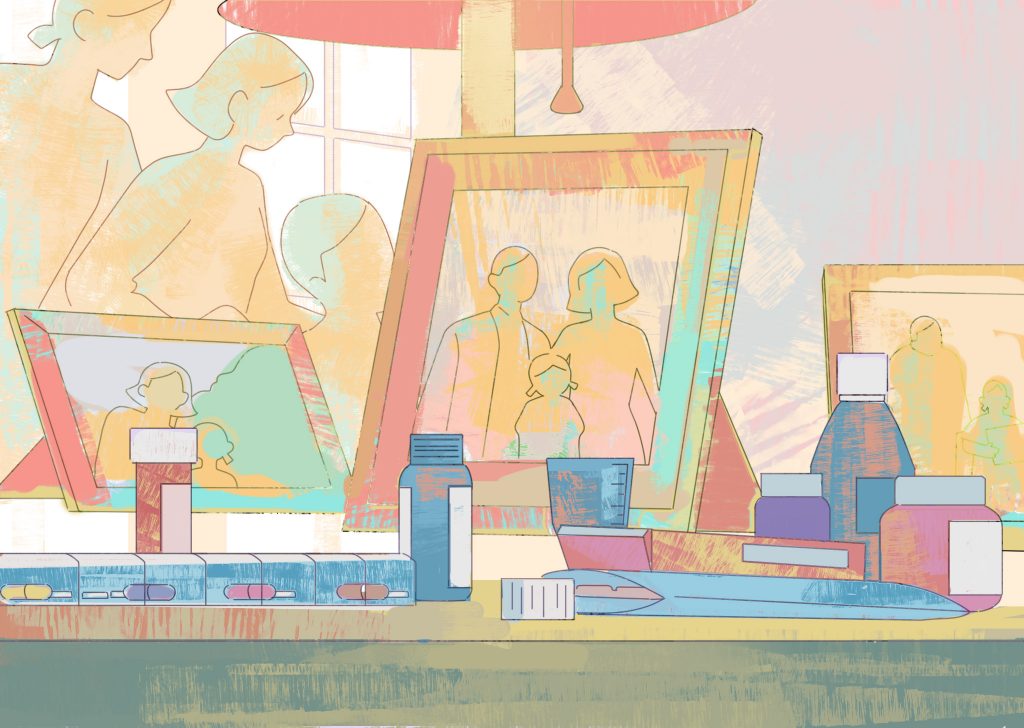All illustrations by Audrey Halim for RICE Media.
“When I grow old, I know you’ll take care of me.”
It’s a sentiment drilled into our minds growing up—whether in television shows, school or in children’s books—that we will eventually pay back our dues to the ones who raised us. Filial piety, it’s called.
My colleague, Kimberly, tells me her grandmother remained in her aunt’s house up until the end. Her aunt powered through those 10 years—mainly with the assistance of a domestic helper—ensuring the bedridden elder remained comfortable and cared for.
It was a grand display of love to the then-impressionable Kimberly, and in some way, her aunt set an example of what filial piety should look like.
An old trope in Singaporean Chinese dramas involves melodramatic sequences of adults threatening to throw their parents into an old folks’ home. Given their method of delivery, these characters are the apparent antagonists in their binary fictional world. The conflict might be dramatised, but it’s reminiscent of Kimberly’s upbringing.
It belies the unspoken expectations that still bind Singaporean adults today: Caring for our parents is a personal mission.
Getting right into the thick of it and caring for our parents when they grow frail is our way of demonstrating filial piety. Opting for palliative care can feel like admitting there’s nothing more we can do for them.
It feels like giving up. It feels like we’ve failed.
Mistaken for Death

Most of us tend to associate palliative care with end-of-life care. It’s an easy mistake to make—from a layman’s point of view they seem interchangeable when they’re not. Heck, even elderly care and nursing homes get thrown into the confusing mix too.
For Dr Yee Choon Meng, undoing this misconception—that seeking palliative care means giving up and choosing death—is part and parcel of his job.
“My role is really to help [patients] manage their symptoms so they remain as comfortable as possible, and also to facilitate the transition of care as they move from the acute hospital settings to a community care setting when curative treatment tapers off,” Dr Yee explains.
As the head and senior consultant in the Division of Palliative Care under the National University Cancer Institute, Singapore (NCIS) Department of Haematology-Oncology, he regularly sees families coming in with their barriers up.
He’s had many caregivers say: “My mother/father isn’t there yet, can I talk to you before you talk to them?”. There’s a clear hesitance to say it out loud: ‘there’ refers to ‘dying’.
When Singaporeans hesitate to talk about death, we actively avoid bringing up anything that might be seen as taboo. Because we believe palliative care is only meant for those who are dying, we refrain from trying to learn more about it, which only fuels the misconception further.
It doesn’t help that over half of local healthcare workers are unfamiliar with palliative care and fail to properly explain it before referring families to his department.
Palliative care, at its core, is meant to provide the best quality of life after a patient receives a life-limiting diagnosis. It’s a type of medical care offered to anyone with a life-limiting illness. It’s meant to help manage symptoms of the illness (pain, anxiety and physical limitations, to name a few) as well as the physical and psycho-emotional stress on both the patients and their caregivers.
It’s not exclusive to the terminally ill. Most of the palliative care patients are those with cancer, though patients with end-stage organ failure are just as common. Patients with advanced dementia are also recognised to have palliative care needs, similar to patients with advanced cancer.
In contrast, end-of-life care only refers to a period of time within a patient’s disease trajectory.
Sure, palliative care doesn’t prolong life, but it also doesn’t hasten death. Many patients receiving palliative care still receive follow-up appointments with their primary physicians, with prognoses that range between months to years.
Once the caregivers understand that their loved ones aren’t being abandoned but instead are receiving additional care and support, they become more receptive to palliative care.
Very often, they’d later admit to Dr Yee: “I wish I had come to you sooner.”
Overcoming Guilt

It’s only natural to feel the primal need to prolong our loved ones’ lives as long as possible, regardless of resources and the resulting quality of life. Depending on how close they are to their loved ones (especially if their loved ones are their parents), prevailing misconceptions make some caregivers feel intense guilt for seeking palliative care.
They believe it’s their filial duty—that they owe it to their parents—to continue to help fight against their illness. That it’s their job to stay optimistic.
“A lot of children feel like they can still do more,” Dr Yee shares. “These feelings, actually, are a part of their grieving process.”
It’s difficult enough for patients to learn their illness is life-limiting, and caregivers experience just as much if not more, grief than the patients themselves.
Palliative care social workers get involved and guide them through the stages of grief and guilt. When they’re emotionally ready, social workers then work with caregivers and patients to decide on the best possible course of care.
In-patient hospice care is sometimes the best course of action depending on the patient’s condition and social situation. Other times, caregivers can manage with support from palliative home care.
The family of one of Dr Yee’s patients—who was paralysed from the neck down due to spine cancer—had originally wanted to care for her by themselves at home where she felt most comfortable. However, once they understood the high degree of care she required wasn’t something they could provide alone, the patient and her family decided to seek palliative care through in-patient hospice services.
Another patient’s family had also chosen not to proceed with inpatient hospice care. As both daughters were trained nurses, they felt they were able to cope with their mother’s nursing care needs in the comfort of their own home, supported by the palliative home care team who regularly visited them.
Even with a logical understanding that palliative care can and will help, there’s still that emotional barrier to overcome.
Dr Yee ultimately wants people to understand that palliative care will always be available to them. Families are free to choose to have the patient return home, knowing that palliative care is a safety net.
At the end of the day, both the palliative care team and caregivers want the same thing for the patient: the best quality of life.
Returning the Space For Families to Be Families

Dr Yee still comes across plenty of caregivers who try to take on the responsibility of caring for their loved ones all by themselves before they burn out.
While recent media coverage on caregiver burnout has highlighted the excessive stress caregivers face, TOUCH Caregivers Support also noted that strained relationships between patients and their caregivers are another unwanted side effect.
Whether it’s due to feelings of inadequacy on the caregivers’ side or a patient’s feelings of guilt for being a burden to their families, tensions will rise with anxiety. It’s hard to come back after hitting a breaking point, and that’s something Dr Yee hopes to prevent from happening.
Beyond addressing a patient’s physical needs, palliative care takes a multifaceted approach by providing social, psychological, and spiritual support to patients and their families. The different teams—from physiotherapists to occupational therapists, pharmacists to allied healthcare professionals, nurses to even chaplains—all work in tandem to be the village that the patient requires.
Not only does palliative care help families cope with the challenges of the illness, but it also frees up their bandwidth to be present and in the moment with their loved ones. If there had to be only one way to remember their time together as a family, let it be a memory of joy.
“I don’t need [the family] to be another doctor or another nurse,” Dr Yee begins. “I only wish for [the family] to continue to be the children they are and spend more quality time with their parents. Don’t worry about the things that are beyond what you can do. We’ll take care of the rest.”
To Be Filial
The complicated feelings we have towards seeking palliative care, especially for our parents, are like an onion. Once we peel back the layers of misconceptions, lack of awareness and guilt, what remains is a pure filial, burning desire to provide the best life possible for them.
Breaking past those barriers is tough, and oftentimes, there’s much discomfort and tears involved. Still, nothing comes easy, and releasing those emotional shackles and understanding and accepting that palliative care is help—not giving up—is the first step forward in achieving that goal.
With greater awareness and understanding of palliative care, it’s plain to see palliative care and filial piety were never exclusive of each other.
Seeking palliative care never made us terrible children; they made us filial ones.







